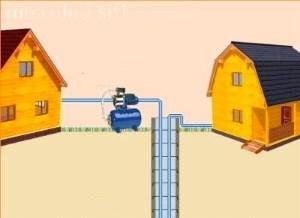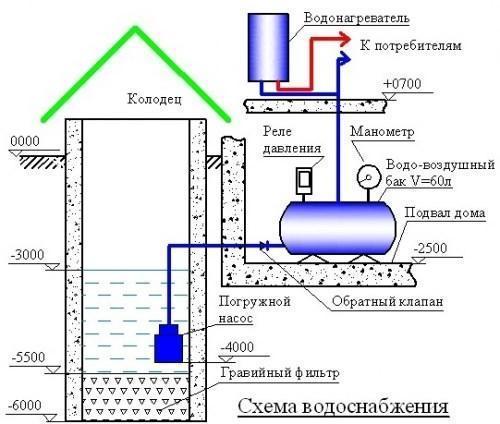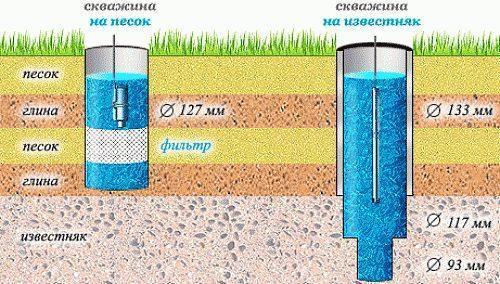DIY water supply
 Water at the summer cottage is extremely necessary - to water the garden, take a shower, cook food, wash the dishes and much more. But, unfortunately, not all houses have a central water supply, and because of this, a number of difficulties arise associated with long trips to the nearest pump or well... You can save time and ensure comfort in the country if you make water supply in the country. This procedure does not require special knowledge and skills and is within the power for independent execution. This will require relatively inexpensive pumping equipment and access to a water source.
Water at the summer cottage is extremely necessary - to water the garden, take a shower, cook food, wash the dishes and much more. But, unfortunately, not all houses have a central water supply, and because of this, a number of difficulties arise associated with long trips to the nearest pump or well... You can save time and ensure comfort in the country if you make water supply in the country. This procedure does not require special knowledge and skills and is within the power for independent execution. This will require relatively inexpensive pumping equipment and access to a water source.
Preparation for water supply of the cottage
Do-it-yourself water supply to the dacha is a process in which many factors must be taken into account in order to ensure the flow of water into the house of good quality and without interruption. It is necessary to decide whether the water supply will work in the winter season or not, how much water will be required per day, for what purposes it will be used. Ideally, the water supply system of the house should be designed together with the building itself, in order to take into account all structural features and establish a convenient water supply system.
Unfortunately, many houses were not designed to carry water in them, so it remains to make changes to the finished buildings. The task becomes more difficult if there is no well within reach or well with water... In this case, you will have to spend a lot of time and money on their construction.

If a well is still available, you should make sure of the quality of its water and its replenishment. If the water flow is insufficient, you can try to make the well deeper. Next, we decide where the pumping equipment will be installed, and if it is superficial, then we allocate a small room for it. A specially designated shed or shed can also serve for all elements of equipment.
Pump selection
The type and power of the pump is selected depending on many factors. So, for water supply to the dacha in winter and summer, you will need different pumps.
By the type of location, the following pumps are distinguished:
- Submersible pump. Installed directly in the well itself. Its advantage is that it does not make noise in the house and does not take up space. However, this type of pump is not applicable during the winter season.
- Surface pump. A more common type, it can be used both in summer and winter. It is located at some distance from the well and is connected to it using a water pipe.
- Pumping station for country houses... These stations can be completely non-volatile. The stations can be diesel or gasoline, they work when the internal combustion engine is turned on.
Choosing a water source
The choice of a water supply source should be made taking into account the level of groundwater, water quality and other factors. You can consult with neighbors who already have a water supply, whether they are satisfied with the purity of their water.
The most common sources of water supply are:
- Well. The most ancient and most convenient way to deliver water home, since you can do the water supply to the dacha from the well with your own hands, without resorting to the help of professionals. It is necessary to purchase only concrete rings, and you can dig a well yourself. In addition, in the absence of electricity and the inability to operate the pump, you can get water from the well using a bucket.Other sources of water supply cannot boast of such dignity. The negative point of using wells is the possibility of various contaminants getting from the upper layers of the soil. But with this disadvantage, careful isolation of the gaps between the concrete rings will help to cope.
- Water supply to the dacha from a well "on the sand". In the absence of groundwater, or in an insufficient amount at a depth of 15 m, it is customary to punch wells. The method of drilling a well "dry" is characterized by the fact that water comes from the uppermost layers of the aquifer system. This water is well filtered by the loam on top, so it is suitable for drinking and cooking. These wells are drilled at a depth of 10 to 50 meters; it is recommended to use classical methods of searching for water, because during machine drilling it is possible to skip a layer of water. Unfortunately, such wells are not durable, because filters are clogged with sand and water sources run out. Depending on the characteristics of a particular winter area, the service life of wells can vary from 5 to 20 years.
- Artesian well. This type of well drilling differs from the previous one in its greater depth, it can reach more than 1000m. Usually artesian wells are not used for their own needs, because this is a rather expensive method of water extraction and requires approval from government agencies. It makes sense to drill such wells by combining the efforts of several neighbors. Artesian drilling water is extracted from limestone layers, where it is the purest and highest quality. The service life of a well can reach that of a well and can be up to 50 years.
Water supply for summer cottages in winter
If it is necessary to use water supply in the winter season, the first step is to dig a trench from the cottage to the water source. The depth of the trench should be at least 1.5-2 m, depending on the characteristics of freezing of the ground in this region. It is possible to lead pipes even higher with mandatory thermal insulation. It is necessary to make a slight slope along the entire length towards the well. A hole is cut in the second ring of the structure to match the dimensions of the selected pipe. Pipes can be steel, plastic, PVC, etc., the main thing is that they do not crack under the influence of frost.

Winter water supply to the dacha from a well with a high level of groundwater involves placing an intake pipe at a height of 30-40 cm from the bottom. At the end of the pipe, a cleaning filter is installed so that soil is not sucked in along with water. The place where the pipe is cut into the ring of the well should be carefully insulated and covered with a trench with sand at the beginning and soil from above.

When installing pumping equipment, the temperature inside the extension, room or separate room where it will be located should be at least 2 degrees Celsius. In front of the pump itself, a water drain valve and a coarse filter are mounted. After passing through the pump, water is filtered in a fine purifier and enters the cold water supply manifold. From the collector, water is distributed among consumers.
Water supply in a private house or in the country is a prerequisite for normal human life and high-quality care of the vegetable garden and garden plot. The level of modern technologies makes it possible to provide water supply on our own at minimal cost. At the same time, the purity of water directly depends on the correctness of all stages of construction and the quality of the equipment used.

Good detailed material for laying plumbing. I just don't know why the author of the article wrote that the submersible pump cannot be used in winter. I carried out the water supply at home with my own hands about 5 years ago. I used a submersible pump (1.5 kW).The water in the well does not freeze in winter, a plastic pipe is removed from the pump, which goes at a depth of 1.5 m to the house. The entrance of the pipe into the room is insulated. This design is very convenient, easy to assemble, does not require additional costs. There have been no problems or interruptions in work over all these years. A surface pump requires an additional room with a certain temperature, as well as a tap for draining water. As for me, these are unnecessary worries.
Of course, such a water supply can be used, with a station or a submersible pump, all year round. For example, we, rural residents, who do not have central water supply, for the most part have moved to pumping stations. In order to prevent your pipes from freezing in winter, it is enough to run a heating cable along them during installation. Then it is easy to warm up pipes even stuck by frost, it is enough to plug the plug from such a cable into the socket.
And if groundwater allows - lay the water pipes below the freezing depth, then you won't need a hassle with a heating cable.